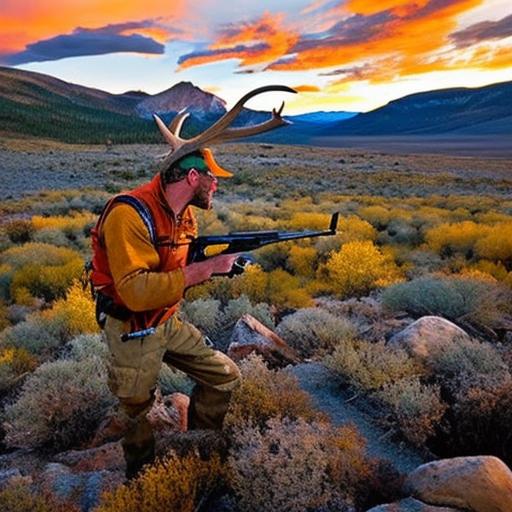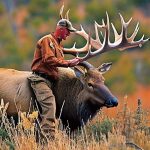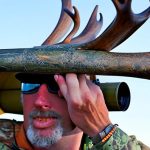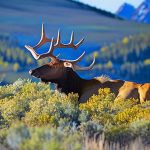Your cart is currently empty!

Unleashing the Thrill of Nevada Elk Hunting: A Guide to the Ultimate Outdoor Adventure

Elk hunting in Nevada has a rich history that dates back to the early 1900s. The state’s vast and diverse landscapes, including mountains, valleys, and forests, provide the perfect habitat for elk populations to thrive. Nevada is known for its large elk herds and trophy-sized bulls, making it a popular destination for hunters from all over the country.
One of the main reasons why Nevada is a popular destination for elk hunting is its limited entry draw system. This system ensures that only a limited number of hunters are allowed to hunt in specific areas, which helps maintain healthy elk populations and ensures a high-quality hunting experience. Additionally, Nevada offers a variety of hunting opportunities, including archery, muzzleloader, and rifle hunts, allowing hunters to choose the method that suits them best.
When planning an elk hunting trip in Nevada, hunters can expect a challenging and rewarding experience. The rugged terrain and unpredictable weather conditions make for an exciting hunt. Hunters should be prepared to hike long distances, navigate steep slopes, and endure changing weather patterns. However, the opportunity to spot and stalk majestic elk in their natural habitat is an experience like no other.
Key Takeaways
- Nevada offers a unique and exciting elk hunting experience for hunters of all levels.
- Proper gear and equipment are essential for a successful and safe hunt.
- Understanding elk behavior and tracking techniques can greatly increase your chances of a successful hunt.
- Choosing the right hunting spot and utilizing effective hunting strategies are key to a successful hunt.
- Safety measures and knowledge of hunting regulations are crucial for a safe and enjoyable experience.
Preparing for the Hunt: Essential Gear and Equipment
Before embarking on an elk hunting trip in Nevada, it is crucial to have the right gear and equipment. Proper clothing and footwear are essential for staying comfortable and safe in the field. Layered clothing is recommended to accommodate changing weather conditions. A good pair of waterproof boots with ankle support is also necessary for navigating rugged terrain.
In terms of hunting gear and equipment, hunters should have a reliable rifle or bow, depending on their preference. It is important to practice shooting and become familiar with the weapon before the hunt. Other essential items include binoculars for spotting elk from a distance, a range finder for accurate distance estimation, and a backpack to carry necessary supplies.
Food and water supplies are also crucial for a successful hunting trip. Hunters should pack lightweight, high-energy snacks and plenty of water to stay hydrated throughout the day. It is also important to have a first aid kit and emergency supplies in case of any injuries or emergencies.
Understanding Elk Behavior: Tips for Tracking and Stalking
To increase the chances of a successful hunt, it is important to understand elk behavior and habitat. Elk are social animals that live in herds, with bulls, cows, and calves forming separate groups for most of the year. They are most active during the early morning and late afternoon, so hunters should plan their hunts accordingly.
When tracking elk, it is important to look for signs such as tracks, droppings, and rubs on trees. Fresh tracks indicate recent elk activity, while rubs on trees suggest the presence of bulls marking their territory. By following these signs, hunters can track elk and get closer to their desired target.
Stalking elk requires patience and stealth. Hunters should move slowly and quietly, using natural cover such as trees and rocks to remain hidden. It is important to stay downwind of the elk to avoid being detected by their keen sense of smell. By staying quiet and undetected, hunters can increase their chances of getting within shooting range.
Hunting Techniques: Strategies for a Successful Hunt
| Hunting Technique | Success Rate | Difficulty Level |
|---|---|---|
| Spot and Stalk | 60% | Hard |
| Still Hunting | 40% | Medium |
| Calling | 70% | Easy |
| Tracking | 50% | Hard |
| Stand Hunting | 80% | Easy |
There are several hunting techniques that can be employed during an elk hunt in Nevada. One popular method is spot and stalk hunting, where hunters use binoculars to spot elk from a distance and then move in for a closer shot. This technique requires patience and careful navigation of the terrain.
Another effective technique is calling and decoying. Elk are vocal animals, especially during the rutting season when bulls bugle to attract cows. By mimicking these calls using bugle tubes or cow calls, hunters can lure elk closer for a shot. Decoys can also be used to attract elk, especially during the rut when bulls are more aggressive.
When it comes to choosing between bow hunting and rifle hunting, it ultimately depends on the hunter’s preference and skill level. Bow hunting requires a higher level of skill and accuracy, as the effective range is shorter compared to rifles. However, bow hunting can be a more intimate and challenging experience, as hunters need to get closer to their target.
Choosing the Right Hunting Spot: Factors to Consider
Choosing the right hunting spot is crucial for a successful elk hunt in Nevada. Several factors should be considered when selecting a location. Terrain and vegetation play a significant role in elk behavior and movement. Elk prefer areas with a mix of open meadows, dense forests, and water sources. By understanding their preferred habitat, hunters can narrow down potential hunting spots.
Water sources are also important considerations when choosing a hunting spot. Elk need to drink regularly, especially during hot weather or drought conditions. By locating water sources such as rivers, streams, or watering holes, hunters can increase their chances of encountering elk.
Weather conditions should also be taken into account when selecting a hunting spot. Elk are more active during cooler weather, so hunting during early mornings or late afternoons when temperatures are lower can be more productive. Additionally, weather patterns such as rain or snow can affect elk movement and behavior.
Lastly, it is important to consider other wildlife in the area. Elk often share their habitat with other animals such as deer, moose, and predators like wolves or bears. By understanding the dynamics of the ecosystem, hunters can anticipate elk movement and avoid areas with high predator activity.
Safety Measures: Ensuring a Safe and Enjoyable Hunting Experience

Safety should always be a top priority during an elk hunting trip in Nevada. Hunters should familiarize themselves with basic safety rules and precautions before heading into the field. This includes knowing how to handle firearms safely, being aware of the location of other hunters in the area, and always wearing blaze orange to increase visibility.
When handling firearms, it is important to treat every gun as if it is loaded and never point it at anything you do not intend to shoot. Hunters should also be aware of their surroundings and have a clear line of sight before taking a shot. It is also important to practice proper gun maintenance and ensure that firearms are in good working condition before the hunt.
In case of an emergency, hunters should have a plan in place. This includes knowing the location of the nearest hospital or medical facility, having a communication device such as a cell phone or two-way radio, and informing someone of their hunting plans and expected return time. It is also important to have basic first aid supplies on hand for treating minor injuries.
Hunting Regulations: Understanding the Rules and Regulations
Before embarking on an elk hunting trip in Nevada, it is important to understand the rules and regulations set by the state’s Department of Wildlife. This includes obtaining the necessary licenses and permits, understanding bag limits and hunting seasons, and knowing the specific regulations for hunting on public versus private land.
To hunt elk in Nevada, hunters must apply for a tag through the state’s limited entry draw system. The application period typically opens in March and closes in April, with results announced in May. It is important to apply early and have backup options in case you are not successful in the draw.
Bag limits and hunting seasons vary depending on the specific hunt unit and weapon type. It is important to familiarize yourself with these regulations before planning your trip. Additionally, hunters should be aware of any special restrictions or requirements for hunting on public land, such as obtaining additional permits or following specific access rules.
Hunting Seasons: Best Times to Plan Your Trip
Nevada offers several hunting seasons for elk, each with its own advantages and considerations. The archery season typically takes place in September, during the elk rut. This is a popular time for hunters, as bulls are more active and vocal, making them easier to locate and call in. However, the archery season can also be challenging, as elk are more alert and wary.
The muzzleloader season usually follows the archery season and provides another opportunity for hunters to pursue elk. Muzzleloaders offer a longer effective range compared to bows, allowing hunters to take shots from a slightly greater distance. This season typically takes place in October.
The rifle season is the most popular and widely accessible hunting season in Nevada. It usually takes place in November and offers a higher success rate compared to archery or muzzleloader hunts. The colder weather during this time can make elk more predictable, as they tend to gather in lower elevations and near water sources.
When planning your trip, it is important to consider factors such as weather conditions, hunting pressure, and personal preferences. Some hunters prefer the challenge of archery or muzzleloader hunts, while others prefer the higher success rates of rifle hunts. It is also important to consider other factors such as work schedules and availability of vacation time.
Accommodations and Logistics: Planning Your Elk Hunting Trip
When planning an elk hunting trip in Nevada, it is important to consider accommodations and logistics. There are several options for lodging, ranging from hotels and motels in nearby towns to camping in designated areas. Some hunting outfitters also offer guided hunts with lodging included.
Transportation options will depend on the location of your hunt and personal preferences. If you are hunting on public land, you may need a four-wheel-drive vehicle to access remote areas. If you are hunting on private land or with a guided outfitter, transportation may be provided.
In terms of packing for your trip, it is important to bring essential items such as clothing, gear, food, and water supplies. It is also important to pack any necessary licenses, permits, and identification. Additionally, it is recommended to bring a GPS or map and compass for navigation purposes.
Other Outdoor Activities: Exploring Nevada’s Natural Beauty
While elk hunting is the main attraction in Nevada, the state offers a variety of other outdoor activities for hunters and non-hunters alike. Hiking and camping opportunities abound in Nevada’s national parks, forests, and wilderness areas. These areas offer stunning landscapes, diverse wildlife, and opportunities to explore nature up close.
Nevada is also known for its fishing and boating options. The state is home to numerous lakes, rivers, and reservoirs that offer excellent fishing opportunities for a variety of species. Whether you prefer fly fishing in a mountain stream or casting a line in a tranquil lake, Nevada has something for every angler.
In addition to hunting, fishing, hiking, and camping, Nevada offers a range of other outdoor activities to enjoy. This includes birdwatching, wildlife photography, horseback riding, and off-roading. The state’s diverse landscapes provide endless opportunities for outdoor enthusiasts to explore and connect with nature.
Elk hunting in Nevada offers a challenging and rewarding experience for hunters of all skill levels. The state’s rich history of elk hunting, limited entry draw system, and diverse landscapes make it a popular destination for hunters from all over the country. By understanding elk behavior, employing effective hunting techniques, and following safety rules and regulations, hunters can increase their chances of a successful hunt.
When planning an elk hunting trip in Nevada, it is important to have the right gear and equipment, choose the right hunting spot, and understand the rules and regulations set by the state’s Department of Wildlife. It is also important to consider accommodations and logistics when planning your trip. Additionally, don’t forget to take advantage of other outdoor activities that Nevada has to offer, such as hiking, fishing, and camping.
In conclusion, a Nevada elk hunting trip is an adventure like no other. The opportunity to spot and stalk majestic elk in their natural habitat, surrounded by the state’s stunning landscapes, is an experience that will be cherished for a lifetime. So, start planning your elk hunting trip to Nevada and get ready for an unforgettable adventure in the wild.
If you’re planning a Nevada elk hunting trip, you might also be interested in learning how to hunt rabbits with a pellet gun. It’s a popular and challenging hunting method that requires skill and precision. Check out this informative article on hunting rabbits with a pellet gun to enhance your hunting skills and expand your hunting opportunities.
FAQs
What is Nevada elk hunting?
Nevada elk hunting refers to the activity of hunting elk in the state of Nevada, USA.
When is the elk hunting season in Nevada?
The elk hunting season in Nevada typically runs from August to December, with specific dates varying by hunting unit.
What are the requirements for obtaining an elk hunting license in Nevada?
To obtain an elk hunting license in Nevada, hunters must be at least 12 years old, complete a hunter education course, and pass a written test. Non-residents must also purchase a non-resident hunting license.
What types of elk can be hunted in Nevada?
In Nevada, hunters can hunt Rocky Mountain elk and Roosevelt elk.
What is the bag limit for elk hunting in Nevada?
The bag limit for elk hunting in Nevada varies by hunting unit and type of elk, with some units having a limit of one elk per season and others having a limit of two.
What equipment is needed for elk hunting in Nevada?
Hunters in Nevada typically use rifles or archery equipment for elk hunting. Other necessary equipment includes appropriate clothing, boots, binoculars, and a hunting knife.
Are there any restrictions on where elk hunting can take place in Nevada?
Elk hunting in Nevada is restricted to specific hunting units, and hunters must obtain a tag for the specific unit they wish to hunt in. Additionally, some units have restrictions on the type of weapon that can be used for hunting.

Herb has been a longtime lover of the outdoors. Whether it be hunting, camping, fishing or just getting outside to reset. Proud father and animal lover. Bourbon anyone?

by
Tags:
Comments

Categories
- Big Game Hunting (301)
- Deer (202)
- Reviews (3)
- Shooting (16)
- Slingshot (1)
- Small Game Hunting (42)
- Upland Hunting (126)
- Waterfowl Hunting (3)





Leave a Reply